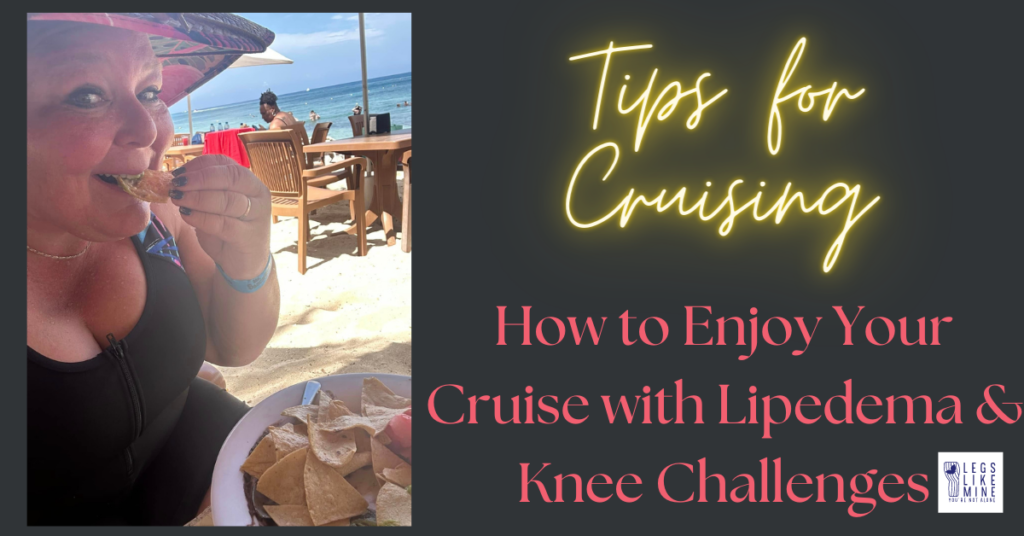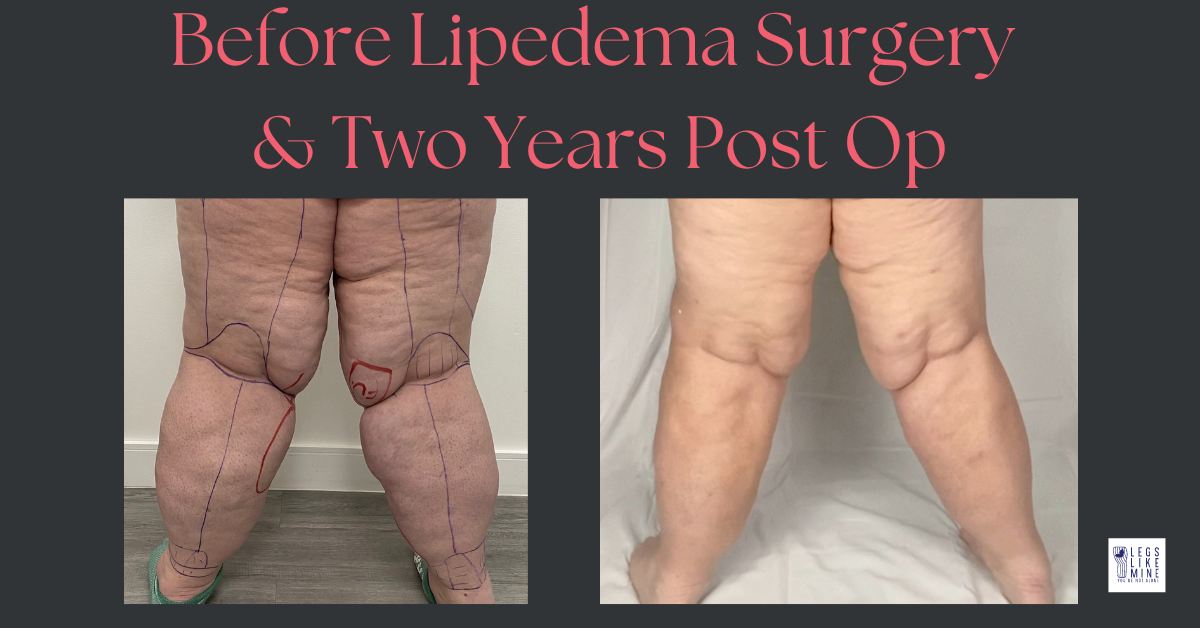Hi friends!
I’ve just returned from a 5-day cruise to Mexico with my adult kids. This is the first time I’ve cruised since my hypermobility and knee damage has kicked into full gear, so I learned a few tips and tricks that I thought I’d share with you. This may be especially helpful if you’ve never cruised before and aren’t familiar with unique features on cruise ships.
Here are my tips:
- Always, always have trip insurance for a cruise. It’s offered through the cruise line when you book, or you can get independent insurance. This covers you if you need medical care on or off the ship, have to cancel due to medical reasons, or if you (or your body – it happens) need to be transported home. Always, always have trip insurance.
- If you have special requirements for lifting your legs, use a scooter or other mobility aid, or will need help getting on and off the ship with your bags, plan these things in advance. Make sure you book an accessible room. Cruise ship bathrooms are notoriously small, and often the showers or baths require a significant step to get in and out of. It’s important that you’re in a room where you can safely get in and out of bathing facilities. For me, on my first cruise many years ago, I was really surprised at how high I had to step to get into the bathtub/shower combo. I couldn’t use one of those today. The good news is that ships usually have many accessible cabins but they do book up pretty early.
- Give yourself time to get to the port. Plan on being there the evening before your ship sails so you can relax in a hotel with legs on the wall, take advantage of ample sized swimming pools that you most likely won’t see onboard, and can avoid the stress of delayed travel, which is bad for our legs.
- If you’re driving or flying to your cruise port, take special precautions to avoid swelling up during your travel. Wear compression, avoid salty and sugary snacks, and drink plenty of water. Also get up to walk around at least every hour to two hours and perform manual lymphatic drainage frequently. As soon as you get to your hotel, either swim for a while or get your legs on the wall for as long as you can stand so you can encourage lymphatic flow. One other item about beachy hotels – do your research on your hotel to make sure your little mom and pop hotel or beachside motel has elevators or can accommodate requests for first floor rooms. Believe me when I tell you that before the cruise is time to avoid stairs, as you’ll experience many opportunities to walk and use stairs on the ship.
- If you need a scooter, consider renting one for on the ship, or even for port visits. Many ports can reserve a scooter for you ship side that you can take with you for getting up and down those sometimes very long piers, and enjoying port facilities and shopping, or to take on your shore excursion. If you bring your own scooter, familiarize yourself with the ship maps. The ship I was just on, the Carnival Breeze, has accessible deck plan maps available online. This is important because there are stairs everywhere on board so you need to plan your routes to be able to use the many elevators on board so you’re not stuck or missing events due to mobility challenges.
- Take advantage of copious opportunities to have fresh fruit, veggies, and water stations on board. Enjoy all the earth’s bounty and flavor while having fresh foods that are good for our bodies. I typically eat more guacamole and watermelon than really should be legal on a Mexico cruise. Seriously, eating a ton of fruits and veggies (that I didn’t have to prepare!) is so good and cleansing for our bodies, so enjoy! Remember to bring a big water bottle to fill up every time you’re near the water stations (cruises provide very small plastic water cups without lids), and know you’re going to be sweating like crazy, so drink that water!

- Many shows take place in the ships’ theatres located at the front of ships. On all the ships I’ve been on, the main theatre has had many levels, with the bottom level being fully accessible, to include no steps and also different seating without arms (think very very large sofas). This is important because the second and so on levels involve many stairs and usually very small and narrov theatre seats that are not comfortable or accessible for people with lipedema. Even when I was 100 lbs lighter, my ample hips would bruise if I sat in these seats. So get to the bottom level of your theatre early for activities so you can enjoy all the shows, use your scooter or mobility aid if needed, and fit properly in the seating.

Lower level theatre seats = good and ample. Upper level theatre seats = misery, hell on earth. - Another tip regarding seating – if you like to spend time on your balcony or on the decks for a sunning session, note that if you look you can find heartier seating without arms. For example on my balcony cabins, I’ve usually had two deck chairs and a footstool.

The deck chairs are, well, miserable if you have a lipedema bum like me. So I use the foot stool as my chair and enjoy the freedom to not be constricted and miserable on my balcony. On the open decks, there usually are some fun seating options aside from the sea of standard deck loungers. Seek those out. On my last trip, I found an area that had heavy duty wicker chairs (I mean HEAVY duty, industrial style) with lovely red leather pillows and sunshades. They were so comfortable, and it appears folks didn’t know about this deck area because it was always available. So it was a bonus! I could get away from the crowd as well as spread out and enjoy better lounging. - Use the handrails and the elevators. Look for hidden elevators on board if you’re wanting to get to the highest decks (sports or adults only areas, usually). You’ll see the vast majority of folks up on those decks get to them by stairs outside. But sometimes you’ll find a small elevator in the front and back of the ship that will take you to the highest decks so you can enjoy the full ship.
- If you’re doing shore excursions, rather than shopping and dining in port shipside, plan your excursions in advance. There are plenty of excursions that are mobility scooter friendly but again, they book up. Usually when you’re in your cruise website in the planning area, you will find options to filter shore excursions that have disability features. You can enjoy lovely beach days, cooking classes, shopping, sightseeing, theatre, arts, and so much more with the aid of a mobility friendly van or bus. So don’t assume that you can’t go and do if you need a scooter or reduced stairs.

Swimming in a cenote that I’d planned in advance with a local guide to have sturdy entry points, handrails, and minimum stairs. - My knees will give me only so many stairs a day before I dislocate and swell. So plan your stairs for what’s most important. I wanted to swim in a cenote (cave like) but the way to them is to take stairs. I planned with my private guide to visit the cenote with sturdy stairs, and limited stairs and a relatively short walk to get to. Some of the cenotes, for example, might have several hundred stairs to get into, and rickety ladders to get into the water. But by using a guide very familiar with the area I was in (progresso Mexico), I was able to participate in a bucket list activity with only a few tylenol to get me through.

There are stairs everywhere on ships. Use the handrails to help pull yourself up to give your knees a break. - Recognize that you do not have to try to go to all the activities on board. Give yourself time for naps and leg elevation, and relaxation. I planned naps into my day and really enjoyed them. Highly recommend.
- Take advantage of spa facilities. I paid a little extra for access to they thermal suites on board. My favorite parts are the lightly heated chairs, cold showers, and a 91 degree thalassotherapy pool filled with seawater. I went to this pool every single day on ship. It features this cooler temp tub, minerals in the water, and so many hard bubbles and jets. I would position my legs over the jets and get free lymphatic drainage, then I’d make my way to the cool showers, lay a towel on a heated bed, and take a nap. It was very good for more sore legs.
- Know there is a ton of walking on ship. Bring your very best walking shoes, and invest in flip flops with good arch support.
- Take advantage of support bars and handrails. I never had a day where my fitness tracker said I had less than 8,000 steps. You’re walking to eat, walking to go to shows, walking to shop, and on port days, really really walking. Even if you’re doing a little shopping in town, getting offboard and even off the pier can be a lengthy walk. By the last day, my knees were shot and I began heavily using arm rails and support bars heavily to help me up and down stairs. I should have been using the handrails to support me a bit more and earlier. You might even invest in a cane with a built in seat like the one below to give you a place to rest.
- Use your compression as often as you can. There are times when my legs swell more than others. Unfortunately heat, humidity, and over movement all trigger a good swell. And all of these things are on board. I definitely wear my compression on embarkation and disembarkation process days, and if I’m not doing water activities on sea days (I will actually hunt out air conditioned paths inside so I can wear my compression on sea days without melting). But there are some days on ship, that I will actually take my compression off. For me its all about outweighing the benefits over the risks, and overheating is a real risk to me, that can ruin a day. So if I’m moving to and from the pools or beach, or staying in air conditioned areas, or taking a nap with my feet elevated, I’ll opt to pull my compression off because the heat can wipe me out with that compression on. I’m not telling you to do this, but this is what I do. A lot of ladies will bring spray bottles and spritz down their compression to stay cool – I do not do this because I hate the way wet compression feels and rubs on my legs where they touch. I just skip it on this rare occasion and get it right back on as soon as I can.
- Bring your swimsuit plus a spare (don’t plan on the ship stores having anything over a size 2x) and enjoy the pools and the beach. One thing I noticed on my last trip is numerous women with lipedema, enjoying, showing their bodies, and having a good time. Know that you will not be alone on a cruise. Get yourself a lovely coverup to walk the halls or cover while you’re in the pool side buffet, and go have fun! Here’s a second tip. Wear your swimsuit under your embarkation outfit so you can use the pools before people who packed their suits and don’t have them while luggage is being delivered, so the pools will be empty on embarkation day until luggage arrives.
- Bring baby powder or anti chafing cream. If you’re going without your usual compression for any period of time, plan on your legs chub rubbing, and bring preventative measures with you. I wore a wet bathing suit that goes to the knee (my famous Juno Active aquatards), to and from the beaches and hydrotherapy pool a lot. My legs rubbed and chafed, and I ended up buying baby powder in Mexico. I’m sure the ship store had some but it would have been very expensive.
- Use little secrets like showering in the free, often-empty, and expansive shower facilities in the ship’s spas or fitness locker rooms instead of trying to cram yourself into the tiny showers in staterooms. I just bring a small bag of toiletries, and a change of clothes, then head up to the locker rooms to shower, use their clean towels, and even hairdryers for a private shower now, and really enjoy the extra space and quiet experience on board. Another secret is to look on the map of the ship in advance and know where accessible restrooms are so when you’re out and about you can find an ample restroom space amidst sometimes extremely small public restroom areas on board.
- Bring a bag of tricks to manage pain and swelling. In my bag of tricks, I have a first aid kit, Rolaids/tums/Pepto, Tylenol, ibuprofen, sunburn cream, anti nausea and motion sickness meds, anti diarrhea meds, arthritis cream, antihistamines, Pepcid (it helps me with MCAS triggers), Benadryl, and quart size Ziplock freezer bags that can be used as ice packs. Next time, I will also bring my leg wraps.
- My final tip is to talk with the cruise line to tell them what you need. They can arrange for dining tables in the front of the dining room that aren’t booths, don’t require using stairs, and require less walking. They can direct you to disability lounge chairs, arrange for wheelchair assistance, and help getting on or off the ship. They really are there to make sure you have fun, so don’t be afriad to ask for what you need!Plan ahead and HAVE FUN!
Susan
Contains paid ads. As an Amazon and Juno Active associate I receive commissions on sales from this blog.
Also, hey! There’s my bathing suit!










